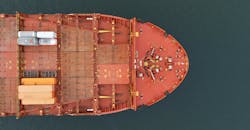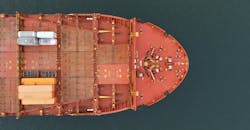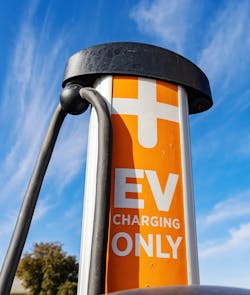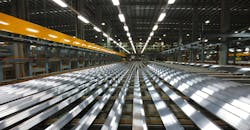At the end of 2021, there were 28% more single-family homes under construction than one year earlier, according to the National Association of Home Builders (NAHB). Add in equally strong starts in multifamily housing, along with a robust commercial sector, and that means there’s no shortage of work for every type of electrical contractor.
The dark lining to that silver cloud is supply chain woes (Photo 1). Like the chronic shortage of journeymen, electricians, electrical foremen, and other positions, the acute shortage of circuit breakers, receptacle outlets, conduit, and other products make it difficult for contractors to meet that demand. This article examines why so many products can’t be found for love nor money — and why that situation is unlikely to improve anytime soon.
Just ask Frank Massiglia, vice president of purchasing at Electrical Dynamics in North Reading, Mass.
“It’s the unknown that is killing us,” he says. “Factories have no clue as to what’s shipping and when. The everyday stuff like black plastic boxes, plugs, and switches we’re being allocated. We can’t get panel covers. We can’t get transfer switches. I don’t see any end in sight.”
More money also doesn’t necessarily make a difference.
“We had a customer who wanted to give us $150,000 up front to get his generator in a hurry,” Massiglia says. “No, 40 weeks.”
What once looked like a temporary problem brought on by the pandemic has officially crossed into chronic territory. That makes it akin to high blood pressure, arthritis, or diabetes: an aggravating, debilitating condition that must be managed indefinitely while holding out hope for a cure somewhere down the road.
“The supply chain issues have been evolving, meaning that what was a problem four to six months ago is now caught up, and we are seeing different products become an issue,” says Cory Borchardt, senior vice president of operations at Fisk Electric in Houston. “Unistrut and fittings were a problem earlier, and are now caught up. Fiberglass conduit and fiber optic cable are now in short supply.
“One segment that has been consistently impacted is the electronic components and circuit boards. Everything from fire alarms to switchgear to LED lighting and GFCI/AFCI outlets have been impacted with price and lead time issues.”
Those fluctuations make it difficult to price jobs — and turn a profit (Photo 2).
“We’ve gone back to a few general contractors looking for relief, especially on copper wire,” Massiglia says. “These are jobs that we wrote in 2020 and 2019. So any job we recorded in 2019 and early 2020, we’re paying the price now that things have tripled and quadrupled in some instances.
“It’s day to day. You get quotes from people: ‘These quotes are good for 24 hours.’ I’ve been doing this for 40 years, and I’ve never seen it this bad.”
Weak links in the supply chain
How did things get so bad? There are multiple reasons, starting with COVID, which came in and crimped production of everything from raw materials to finished products at a time when they were already in high demand. So when mines and factories reopened, they faced an even bigger backlog. This problem persists two years later, as FMI senior economist Brian Strawberry noted in a recent survey.
“One of the respondents is involved in the electrical vehicle and battery plant market,” says Strawberry, who leads FMI’s research in construction material pricing and consumption trends. “He said that their backlog is three times larger than he’s ever seen it.”
Electric vehicles (EVs) also are an example of how a fast-growing sector can be a double-edged sword (Photo 3): On the plus side, EVs mean more business for contractors that install chargers and other infrastructure. But EVs also mean more competition for raw materials.
“The demand for electronics and copper for electrical vehicles is going to have a long-term impact on the supply chain,” says Fisk’s Borchardt.
COVID also continues to rear its ugly head in the worst possible places from a supply chain perspective. Take Baise, a Chinese city that produces a big chunk of the world’s aluminum. When it went into a COVID lockdown in February, global aluminum prices spiked to a 14-year high (Photo 4). And similar shortages plague other metals.
“That’s the problem with plugs and switches: They can’t get brass,” says Electrical Dynamics’ Massiglia. “And we’re talking major manufacturers: ABB, Siemens, Cutler-Hammer.”
The war in Ukraine is just the latest disruptor. It’s part of the reason why fuel prices keep setting new records, leading to shipping surcharges that get passed down the line. Even if peace were struck tomorrow, prices would remain high because of other factors, such as declining refining capacity in the United States.
Another example is tungsten, found in a wide variety of products used by the electrical industry, including semiconductors, halogen lamp filaments, and cutting tools such as drill bits.
“When you get into precision [cutting] work, you can’t substitute it,” says Lewis Black, CEO of Almonty Industries, an international company that specializes in mining tungsten.
And in the case of semiconductors, the tungsten shortage’s impact goes beyond just electrical products such as industrial breakers and LED lighting. For example, the semiconductor shortage is also hammering automakers, making it tough for contractors to find enough new work trucks and vans.
Why is tungsten in such short supply? As with the rest of the supply chain, there are multiple factors, such as older mines whose yields are diminishing due to age, stringent new environmental regulations in China, and geopolitical tensions.
“You’ve seen energy supply issues, especially in China’s ongoing argument with Australia, who’s their largest provider of coal,” Black says. “When you have no power, and mines shut down, it takes some time to reopen. But more importantly, you need energy just to keep the water out to preserve the mine. You can’t have extended periods without energy.”
Politics in play
Wars and disputes aren’t the only political factors affecting the supply chain. In addition to the already overwhelming marketplace-driven demand, there’s also the $1.2-trillion Infrastructure Investment and Jobs Act (IIJA).
“Critical labor and material shortages, along with delivery (trucking) resources, may impact speed of equipment availability for the infrastructure envisioned by the IIJA and the American Rescue Plan Act (ARPA), as well,” says Marty Travers, executive director at Overland Park, Kan.-based Black & Veatch.
Fisk is hearing about the transportation aspect from some of its suppliers.
“We are being told the problem is mostly related to transportation and raw materials and less about COVID shutdowns at this point,” Borchardt says. “That was not the case in spring/summer 2021. Transportation costs are impacting pricing dramatically.”
In a March EC&M article, electrical contractors and officials from organizations such as the National Electrical Manufacturers Association (NEMA) said they expect the bulk of IIJA-funded projects to begin next year. So even if manufacturers and their suppliers miraculously cleared their backlogs in the next six months, they’d face a crush of new IIJA-related orders.
“I think a small portion of it [will be] in 2022, but I think it’s going to have a larger impact over the following years — 2023, 2024, 2025 — especially with the magnitude and the size of the projects,” Russ Lancey, president and CEO of Ozone Park, N.Y.-based Five Star Electric, told EC&M in a previous article on infrastructure revitalization.
The IIJA also has “Buy America” provisions, which create additional supply chain limitations because many projects need products that currently aren’t manufactured in the United States. On the plus side, there are signs that the federal government recognizes this challenge. For example, in May, the Department of Transportation issued a temporary waiver for construction materials — albeit only through November 10, 2022, rather than the 12 to 24 months advocated by groups such as the American Association of State Highway and Transportation Officials.
Shortages also threaten adjunct markets such as broadband.
“You’re looking at very long lead times on fiber, in particular,” says Steve Truebner, a Black & Veatch director who oversees broadband projects. “Once you have a project ready and the community is excited about improved connectivity, nothing slows the momentum of the effort like an added 10-month delay. Some public entities are taking an alternative route by allocating a portion of grant dollars to place advanced orders of the fiber that they know will be needed, in lieu of direct financial grants. It’s an innovative model — and requires the right level of planning to match up with all of the other network components that are associated.”
Could the feds do more than issue waivers? Should they, for that matter? Some say it’s best to let the marketplace work things out.
“Unfortunately, there’s nothing anybody can do,” says Almonty’s Black. “The worst thing that can actually happen is if governments try to fix it. That would be an unmitigated disaster because it’s not a domestic issue. It’s a global issue. Politicians generally aren’t really the best to fix problems, especially complex ones that they have no real understanding of. So, it’s better if they just take a back seat and let the markets find the balance — because the markets will find balance. It’ll just take time.”
Coping strategies
To keep projects on track, some contractors are turning to refurbished/reconditioned equipment. As Joseph Martin, manager of procurement at Pittsburgh-based Sargent Electric told EC&M more than a year ago in a related article: “Plants are shut down. Things are backordered. We’ve gone to our customers and said: ‘Here’s an option. We can get this completed in the five weeks you want, or it’s going to take us 12 just to get the materials.’”
Other contractors say that refurbs often aren’t an option.
“At Fisk Electric, we have been doing a lot of substitutions and alternate products to cut down on lead times,” Borchardt says. “Having an open dialogue with the owner and engineering team early has helped us minimize the impacts. We have not been able to utilize reconditioned or used equipment on any of our projects. When a substitution is not possible or approved by the owner/engineer, we are finding ways to continue the project with temporary items and trying to minimize rework when permanent materials do come available.”
In some cases, refurb equipment isn’t an option because it’s not available, either.
“You can’t get [new] transfer switches,” says Electrical Dynamics’ Massiglia. “I reached out to a lot of used people on the transfer switch side. I had no luck with anything. I hate to use the term ‘new normal,’ but I think we’re seeing it.”
Tim Kridel is an independent analyst and freelance writer. He can be reached at [email protected].
About the Author
Tim Kridel
Freelance Writer
Kridel is an independent analyst and freelance writer with experience in covering technology, telecommunications, and more. He can be reached at [email protected].




